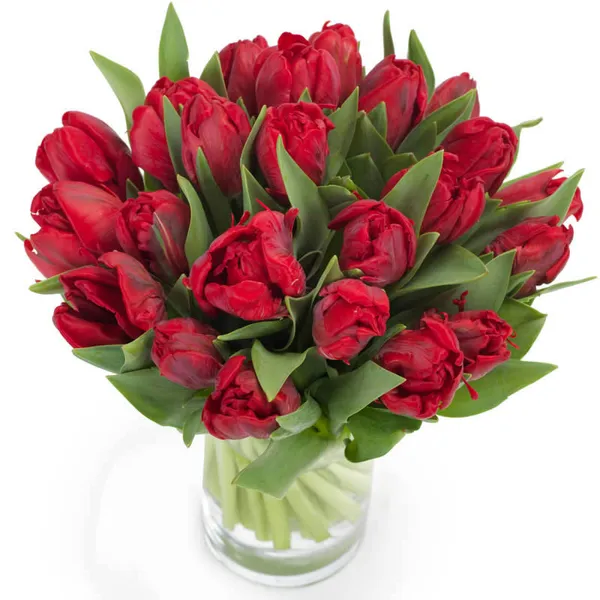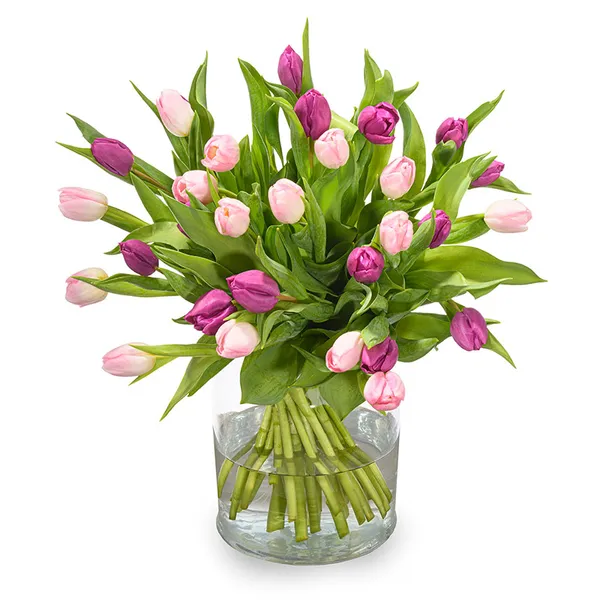Tulips: The Striking Symbol of Spring and Love
Tulips are one of the most beloved and recognisable flowers, known for their simple yet elegant cup-shaped blooms. They are closely associated with springtime and symbolise love, renewal, and elegance. Originating from Central Asia, tulips gained immense popularity during the "Tulip Mania" of the 17th century in the Netherlands, where they became a symbol of wealth and beauty. Available in nearly every colour, tulips are versatile flowers suitable for romantic gestures, celebrations, and modern floral designs.
COMMON NAME
Tulip
BOTANICAL NAME
Tulip spp.
ORIGIN
Central Asia and Turkey
PEOPLE ALSO CALL IT
Queen of the spring, Bulb flower
FLOWERING TIME
Spring (March to May)
ASPECT
Full sun
SYMBOLISM
Love, renewal, prosperity, elegance
Care Tips for a Cut Tulips in a Vase
Trim Stems at a Straight Angle: Re-cut the stems straightly before placing them in water for optimal hydration. Pro-tip from our experiences flower expert and florist Anette Nilsson: Keep the tulips in their wrapping the first hour when cut and placed into water to get the stems straight when they fill up the cells with water.
Use Cold Water: Tulips prefer cold water; replace the water daily to keep it fresh. Our flower expert Anette advises: Keep the water level in the vase low so that it just covers the lower part of the stems. Filling up the water a bit every day is better than adding a big amount of water at once. This is because when the stems are covered high in water, it stimulates the tulip to grow more which results in drooping blooms.
Keep Away from Heat and Sunlight: Place the vase in a cool spot, away from direct sunlight and heat sources, as tulips are sensitive to temperature changes.
Minimal Floral Food: Use floral preservative sparingly to avoid overstimulation of growth, as tulips continue to grow even after being cut.
Support Stems: Tulips have a natural tendency to bend toward light, so arrange them in a tall vase for support and rotate the vase occasionally.
Which Vase Fits my Tulips Best?
Classic tulip vase with wavy rim
When someone talks about a tulip vase, we often think of a vase with uneven and wavy edges. These are made especially for tulips. The shape gives them support as they stretch out towards the light.
Old-fashioned Dutch tulip vases
It used to be customary to put tulips in special vases with a separate hole for each flower. Such special vases were supposed to both show the beauty of the flowers and be a sign of wealth. Tulips were very expensive and were certainly not affordable by everyone. These typical Dutch vases used to be very common. Maybe you have been able to admire them in a museum?
Symbolism & Meaning
Wondering what tulips represent? They carry varied meanings depending on their colour. Red tulips symbolise deep and passionate love, while yellow ones represent happiness, friendship and cheerful thoughts. Pink tulips convey affection and good wishes, white tulips signify forgiveness and purity, and purple tulips symbolise royalty and elegance. As the flower for spring, tulips are often associated with fresh starts and renewal, making them a popular choice for gifts and celebrations of life’s milestones.
Types of Tulips
Tulips come in a wide range of varieties, categorised into different groups based on their bloom shape, size, and flowering time. Single Early Tulips bloom first in spring and feature classic cup-shaped flowers. Double Late Tulips are characterised by their lush, peony-like petals. Parrot Tulips have fringed, feathered petals that give a bold, exotic look. Fringed Tulips have petals with serrated edges, adding a unique texture. Triumph Tulips, a hybrid group, are known for their durability and vibrant colours, making them ideal for both gardens and arrangements.
Frequently Asked Questions About Tulips
Yes, tulips are toxic to cats. The bulbs contain tulipalin A and B, which can cause symptoms like drooling, vomiting, diarrhea, and lethargy if ingested. Keep tulips, especially the bulbs, out of reach of cats.
Plant tulip bulbs in autumn (September to November), about 6-8 weeks before the ground freezes. This gives them time to establish roots for blooming in spring. Plant them in well-draining soil at a depth of 15-20cm, with the pointed end facing up.
After tulips have finished blooming, do the following:
-
Deadhead remaining flowers to prevent seed production but leave the leaves intact.
-
Allow the foliage to die back naturally to nourish the bulbs.
-
In climates with harsh summers or winters, dig up the bulbs, dry them, and store them in a cool, dark place until replanting in autumn.
Yes, tulips are toxic to dogs. The bulbs are the most toxic part and can cause vomiting, diarrhea, and drooling if ingested. Severe cases may result in increased heart rate or difficulty breathing. Contact a vet if ingestion occurs.
Tulips bloom in spring, typically from March to May, depending on the variety:
-
Early-blooming varieties: Late March to early April
-
Mid-season varieties: April
-
Late-blooming varieties: Late April to May
-
Tulips should not be cut diagonally (unlike many other flowers) but straight. This is because they absorb too much water when cut diagonally which makes them top-heavy. If the tulip becomes top-heavy, it starts drooping.
-
Use cold water and change it every two days.
-
Place tulips in a cool location, away from direct sunlight, heat, or drafts.
-
Add a small amount of floral food to the vase to help keep stems upright.
Tulips typically last 5-7 days in a vase with proper care. Fresh water, cool temperatures, and trimming stems every couple of days will help them stay fresh for longer.
To extend the vase life of your tulips, do the following:
-
Trim stems and refresh water every 1-2 days
-
Keep them in a cool, shaded spot
-
Avoid placing them near ripening fruits, as ethylene gas can shorten their lifespan
-
Use a small amount of flower food to nourish the flowers
A common mistake is to cut tulips - like other flowers - at an angle. But with tulips it is better to do it straight. The tulip is a very thirsty flower and keeps on growing with all the water it absorbs. This makes it top-heavy and causes it to droop. The larger the cut surface is, the more water the tulip can absorb. So, by cutting the stem straight, you keep the opening as small as possible, and the tulip will not grow too quickly.


